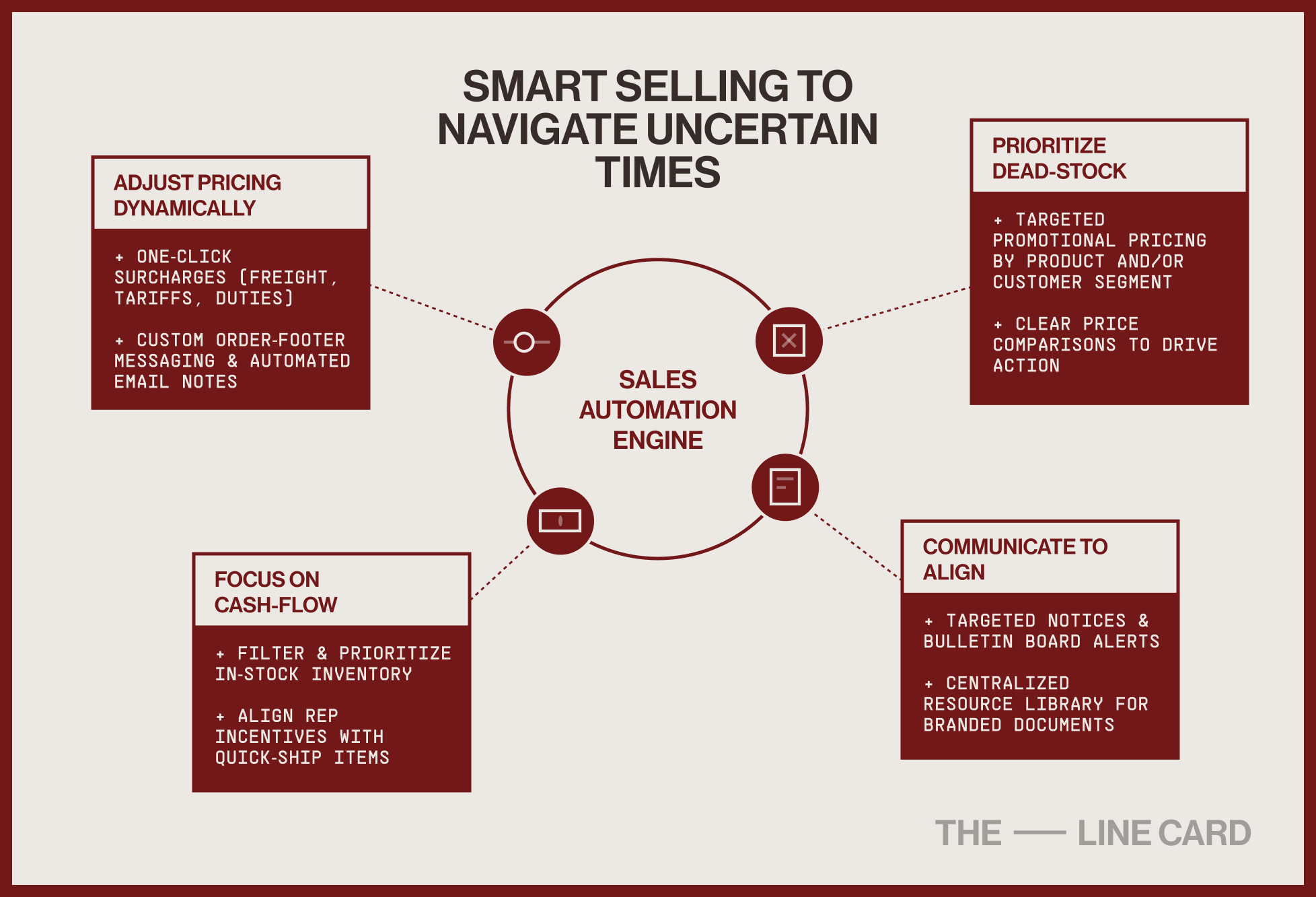 Recently, significant fluctuations in container freight costs, tariffs, and other factors have made it increasingly challenging for manufacturers and distributors to price imported products accurately and maintain viable operating margins. These external pressures often unpredictable and outside the seller's control can drastically impact landed costs, profit forecasts, and customer pricing strategies.
Recently, significant fluctuations in container freight costs, tariffs, and other factors have made it increasingly challenging for manufacturers and distributors to price imported products accurately and maintain viable operating margins. These external pressures often unpredictable and outside the seller's control can drastically impact landed costs, profit forecasts, and customer pricing strategies.
Acting quickly is essential for long-term business resilience. Companies that lack real-time pricing tools, flexible quoting systems, or centralized sales data often find themselves stuck in manual workflows unable to respond before costs eat into their margins. In contrast, businesses that embrace sales automation platforms can rapidly adjust pricing, apply temporary surcharges, and communicate changes across their sales teams and customers in just a few clicks.
Adapting pricing with sales automation tools
Most of SuperCat’s clients have had to deal with wildly fluctuating freight costs, extreme delays of in-transit imported goods, and unpredictable customs duties.
During these times, eCat offers tools that facilitate agile and rapid adaptation to changing circumstances.
Update pricing with a few clicks
Automatically apply freight, tariff/customs duty, and other temporary surcharges to eCat and eCat Online orders as a fixed amount or percentage of the order. As the situation changes, these can be easily changed with a few clicks in the eCat admin console.
Keep customers informed
To ease communication with customers, use eCat’s order footer and customizable order email features to describe special charges, their nature, why they are necessary, etc.
In fact, emails come with a lot of features. If you want to learn how to sell smart with eCat, read this article.
Improving cash flow with inventory-based sales automation
In times of economic uncertainty, maintaining a healthy cash position is critical, and one of the most effective ways to do that is by prioritizing in-stock inventory. SuperCat’s eCat platform helps B2B manufacturers and distributors turn inventory into revenue by making real-time availability visible and actionable for your sales team.
With full visibility across the supply chain from factory floor to in-transit stock to multiple warehouse locations, your team can use smart filters to focus sales efforts on what’s ready to ship now.
Filter and Prioritize In-Stock Inventory
eCat allows reps to filter products based on availability, ensuring that quick-ship items are promoted first. This speeds up delivery times and improves customer satisfaction, especially for time-sensitive buyers.
Increase Rep Motivation and Commission Speed
Sales reps are naturally incentivized to focus on in-stock products, knowing that faster delivery often means faster commissions. This alignment keeps your team energized and your pipeline moving.
Boost Inventory Turns and Reduce Carrying Costs
Focusing on available inventory doesn’t just improve cash flow, it increases inventory turnover, cuts holding costs (typically 20–30% annually), and avoids the risk of discounting or liquidation later.
Using sales automation to turn obsolete inventory into revenue
Slow-moving inventory ties up warehouse space and working capital, and selling it off to liquidators often means taking a loss. With the right sales automation platform, you can proactively turn unsold stock into profit by promoting it to the right buyers at the right time.
SuperCat’s eCat platform gives B2B manufacturers and distributors flexible promotion tools to manage dead stock, returned goods, or aging components — all within a centralized, real-time product catalog.
Promote slow-moving inventory with targeted offers
Whether you’re clearing out finished goods, outdated fabric rolls, or components nearing obsolescence, eCat allows you to apply promotional pricing easily. These offers can be adjusted by product group, customer segment, or territory, helping you recover value without relying on steep markdowns.
Show price comparisons clearly to drive action
eCat displays both the original and discounted prices at each customer’s specific pricing level. This transparency not only builds trust but also highlights the real value of your promotion, making it easier for reps to close and for customers to act quickly.
Update promotional pricing in real time
You can update or expire promotional pricing instantly through the Admin Console, giving your sales and marketing teams full control over pricing strategy without delays or errors. This helps you test discounts, react to market shifts, and make data-driven pricing decisions.
Boosting communication through sales automation
Real-time communication is essential in volatile markets where pricing, inventory, and policies can change rapidly. Sales teams that rely on outdated email threads, PDFs, or verbal updates risk confusion, missed opportunities, and operational delays. That’s why forward-thinking B2B teams use sales automation platforms like eCat to keep everyone aligned instantly and in one place.
Deliver instant internal updates with eCat notices and bulletins
The eCat Notices and Bulletin Board feature lets administrators publish time-sensitive updates directly within the eCat interface to specific groups of users. Whether you need to inform reps about:
- Temporary surcharges or freight changes
- New product launches or discontinued SKUs
- Updated territory assignments or sales incentives
After the notice is viewed and dismissed, it’s available for ongoing view in the Library Notices (Bulletin Board).
Resource library for centralizing branded documents
The eCat Resource Library acts as a single source of truth for internal teams and external partners. Here, your business can upload and organize:
- Branded white papers
- Policy statements and pricing terms
- Marketing brochures and sales playbooks
- Installation guides, technical specs, or fabric swatches
Files can be grouped by category, tagged by audience (e.g. “Sales Reps,” “Dealers,” or “Internal Only”), and marked as downloadable or view-only. This helps your team:
- Quickly find and share materials with customers
- Stay consistent in communication and brand messaging
- Reduce time spent searching across shared drives or email threads
Sales automation with eCat turns chaos into control
Sales automation doesn’t just help you react faster. It gives you the infrastructure to:
- Respond to pricing shifts in real time
- Prioritize inventory that protects cash flow
- Equip reps to sell smarter
- Keep customers and internal teams aligned
Platforms like eCat turn complexity into clarity and help B2B sellers stay profitable, even when the market isn’t predictable.
Frequently Asked Questions
What’s causing pricing instability in B2B sales today?
Tariffs, freight cost spikes, port backlogs, and unpredictable customs duties are major disruptors. These external forces increase landed costs, making it difficult for manufacturers and distributors to maintain stable margins or offer reliable pricing.
How can sales automation help respond to rising tariffs or freight charges?
Sales automation platforms enable you to apply temporary surcharges, such as freight or tariff costs, directly to customer orders. With a few clicks, pricing adjustments can be rolled out across your catalogs, helping you maintain margins and communicate changes clearly to customers.
Is sales automation just about quoting and orders?
Not at all. Sales automation covers everything from pricing and product visibility to inventory prioritization, team communication, and customer self-service. It’s the digital backbone that helps B2B sellers scale effectively and respond to market change with agility.
Disruption isn’t going away — but disorganization can.
Smarter Selling Starts in Your Inbox
Get exclusive playbooks, guides, and case studies delivered monthly
